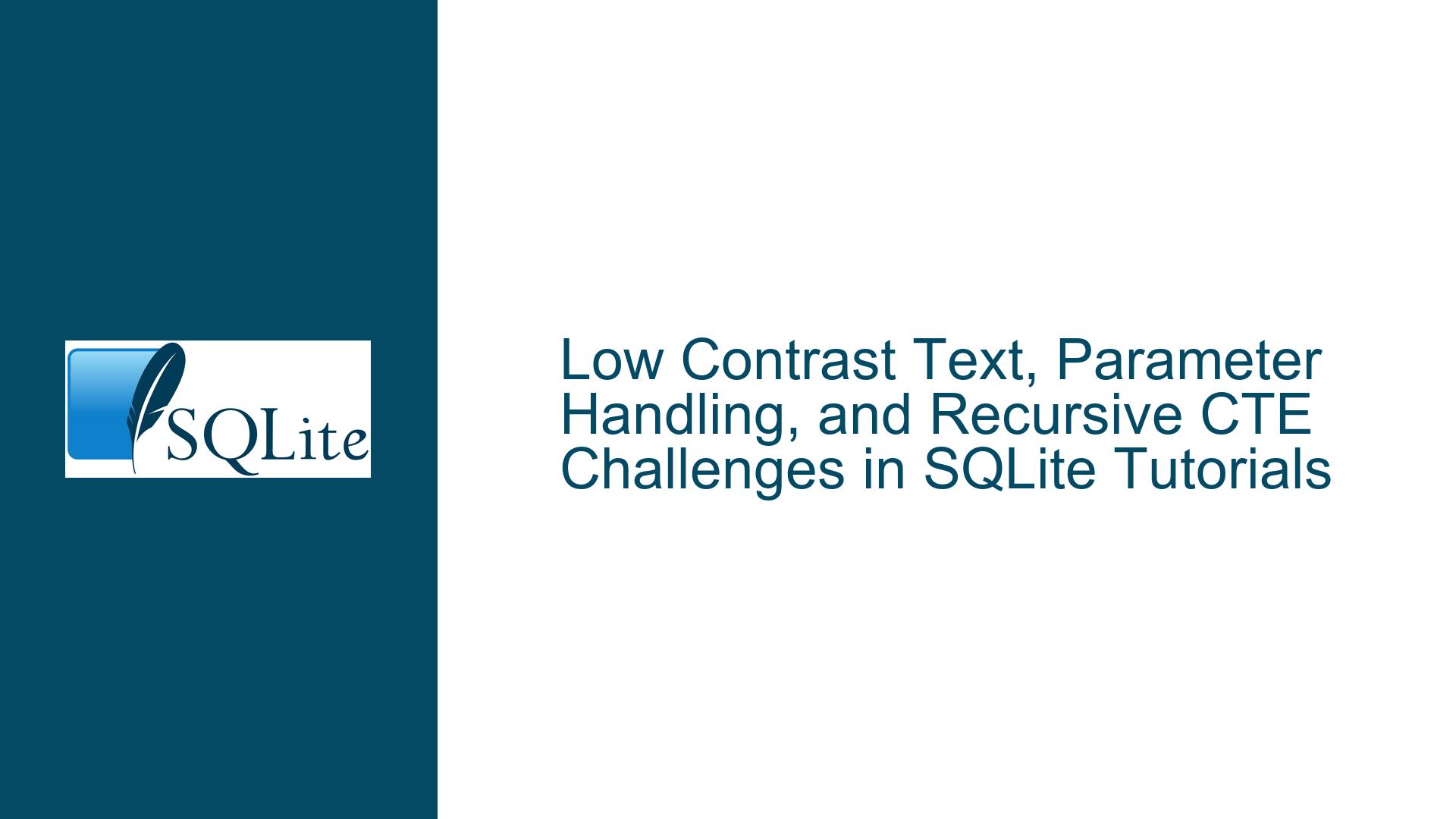Low Contrast Text, Parameter Handling, and Recursive CTE Challenges in SQLite Tutorials
Addressing Low Contrast Text and Code Block Readability in SQLite Documentation
Issue Overview
The primary issue revolves around insufficient color contrast between text/code elements and their backgrounds in SQLite tutorial materials, hindering readability. Users reported difficulty discerning content due to light-gray text on off-white backgrounds, particularly in code blocks. This problem is exacerbated by variations in display hardware, browser settings, and default themes (e.g., GitHub Pages’ JustTheDocs). Low contrast violates WCAG accessibility guidelines (minimum 4.5:1 for normal text), causing eye strain and reducing content comprehension. Code blocks with improper syntax highlighting further obscure keywords and structural elements, making SQL examples harder to parse.
Possible Causes
- Default Theme Limitations: GitHub Pages’ JustTheDocs theme uses subdued colors for body text (#363636) and code blocks with light-gray backgrounds, which fail to provide adequate contrast on non-retina displays or under bright lighting.
- Browser-Specific Rendering: Older browsers or those with user-defined style sheets (e.g., forced dark modes) may override author styles, creating unintended contrast issues.
- Syntax Highlighter Misconfiguration: The absence of a syntax highlighting library in static site generators leads to manual CSS styling, often resulting in inconsistent keyword/comment/string colors.
- Device-Specific Gamma Calibration: Variations in screen gamma settings (common across iPads, laptops, and external monitors) alter perceived brightness, making contrast issues device-dependent.
Troubleshooting Steps, Solutions & Fixes
Audit Contrast Ratios:
- Use tools like WebAIM’s Contrast Checker to verify foreground/background pairs. For body text, ensure a contrast ratio ≥7:1 (e.g., #000000 on #FFFFFF).
- For code blocks, adopt high-contrast themes like Solarized Dark or VS Code’s default dark/light themes, which define explicit colors for keywords and literals.
Override Default Theme Styles:
- Modify the site’s
_sass/custom/custom.scssto enforce black text:$body-text-color: #000000; $code-background-color: #f8f8f8; .highlight { background-color: $code-background-color; } - Use browser developer tools (F12) to inspect elements and test CSS overrides interactively before committing changes.
- Modify the site’s
Implement Responsive Syntax Highlighting:
- Replace manual code coloring with a Jekyll-compatible highlighter like Rouge, configuring
_config.yml:markdown: kramdown kramdown: syntax_highlighter: rouge syntax_highlighter_opts: css_class: 'highlight' default_lang: sql - Generate CSS for SQL syntax via
rougify style github > syntax.cssand include it in the site header.
- Replace manual code coloring with a Jekyll-compatible highlighter like Rouge, configuring
Browser-Specific Workarounds:
- Instruct users to enable "Ignore page colors" in Firefox or "Force Dark Mode" in Chrome to bypass low-contrast author styles.
- Provide a print stylesheet with forced high-contrast settings for users relying on PDF exports.
Optimizing Parameter Handling and Query Structure in Complex SQLite Workflows
Issue Overview
A critical challenge in SQLite query design is managing multiple input parameters while avoiding tight coupling between application logic and database schemas. Traditional approaches rely on dynamic SQL generation with inline bind variables (e.g., :param), leading to code duplication and maintenance hurdles. The discussion highlights strategies to centralize parameter management using CTEs and JSON objects, enabling static queries with dynamic behavior. Key pain points include scattering bind variables across subqueries, lack of input validation, and difficulty testing multi-parameter queries interactively.
Possible Causes
- Dynamic SQL Proliferation: Applications generating SQL strings on-the-fly to accommodate varying parameters introduce injection risks and hinder query optimization.
- Decentralized Bind Variables: Parameters referenced in nested subqueries or window functions complicate testing, as values must be bound in multiple contexts.
- Schema Dependency: Hardcoded table/column names in application logic create brittleness when schema changes occur.
- Unstructured Parameter Inputs: Passing individual scalars instead of structured JSON objects limits flexibility in handling optional or conditional parameters.
Troubleshooting Steps, Solutions & Fixes
Centralize Parameters with CTE Variables:
- Define a
argsCTE at the query outset to bind all input parameters as a single row:WITH RECURSIVE args(machine_id, width, depth) AS ( VALUES (:machine_id, :width, :depth) ), ... - Reference
argsin subsequent CTEs viaJOIN args USING (machine_id), eliminating scattered bind variables.
- Define a
JSON Parameter Unpacking:
- Accept a single JSON string parameter and unpack it using
json_extract:WITH args AS ( SELECT json_extract(:json_input, '$.machine_id') AS machine_id, json_extract(:json_input, '$.width') AS width ) - Validate JSON schema inline with
json_error_position()(SQLite 3.42+) to reject malformed inputs.
- Accept a single JSON string parameter and unpack it using
Parameter Validation Views:
- Create reusable validation CTEs to enforce constraints:
WITH args(...) AS (...), validated_args AS ( SELECT * FROM args WHERE width BETWEEN 1 AND 100 AND depth IS NOT NULL ) - Use
CASEstatements orRAISE()in triggers to provide descriptive error messages.
- Create reusable validation CTEs to enforce constraints:
Testing Interfaces:
- Replace the
argsCTE with staticVALUESduring development:WITH args(machine_id, width) AS ( VALUES (123, 50) -- Test values ) - Utilize SQLite’s CLI
.parametercommand to set bind variables interactively.
- Replace the
Implementing Hierarchical Data Models with Recursive CTEs and Materialized Paths
Issue Overview
Hierarchical data modeling in SQLite using the Materialized Paths (MP) pattern presents challenges in maintaining referential integrity, optimizing tree traversal, and avoiding infinite recursion loops. The discussion explores combining recursive CTEs (rCTEs) with JSON to represent paths, but common pitfalls include incorrect termination conditions, missing indexes on path columns, and failure to enforce MP structural invariants. A typical scenario involves querying subtrees or ancestors, where improper rCTE joins result in incomplete or cyclic outputs.
Possible Causes
- Inadequate Indexing: Materialized paths stored as strings (e.g.,
/1/3/7/) without full-text search indexes lead to slowLIKEqueries. - Uncontrolled Recursion Depth: rCTEs without a
LIMITclause or cycle detection may loop indefinitely on cyclic graphs. - Path Structure Violations: Application-level inserts/updates that create malformed paths (e.g.,
//3or1/3/) corrupt hierarchical integrity. - Implicit Casting Issues: Storing path components as integers within strings risks comparison errors (e.g.,
'2' > '10').
Troubleshooting Steps, Solutions & Fixes
Structured Path Storage:
- Enforce MP format constraints using
CHECKclauses:CREATE TABLE categories ( id INTEGER PRIMARY KEY, path TEXT CHECK(path GLOB '/*/[0-9]/*') ); - Store path components as zero-padded strings (e.g.,
/0001/0003/0007/) to enable correct lexicographical ordering.
- Enforce MP format constraints using
Optimized rCTE Traversal:
- Use
WITH RECURSIVEto traverse ancestors or descendants:WITH RECURSIVE subtree AS ( SELECT id, path FROM categories WHERE id = :target UNION ALL SELECT c.id, c.path FROM categories c JOIN subtree s ON c.path = s.path || c.id || '/' ) - Terminate recursion by tracking depth:
SELECT ..., depth FROM subtree WHERE depth <= 5
- Use
Cycle Detection:
- Augment rCTEs with a cycle tracking column:
WITH RECURSIVE graph(id, visited) AS ( SELECT id, json_array(id) FROM nodes WHERE id = :start UNION ALL SELECT e.to_id, json_insert(visited, '$[#]', e.to_id) FROM graph g JOIN edges e ON g.id = e.from_id WHERE json_each(visited) <> e.to_id )
- Augment rCTEs with a cycle tracking column:
Indexing Strategies:
- Create virtual tables using FTS5 for efficient path searches:
CREATE VIRTUAL TABLE category_paths USING fts5(path); - Use generated columns to materialize path components:
ALTER TABLE categories ADD COLUMN parent_id INTEGER AS (CAST(substr(path, -8, 4) AS INTEGER)) VIRTUAL;
- Create virtual tables using FTS5 for efficient path searches:
By systematically addressing contrast issues, centralizing parameter management, and applying structural constraints to hierarchical models, developers can enhance both the usability of SQLite documentation and the robustness of complex query designs.






